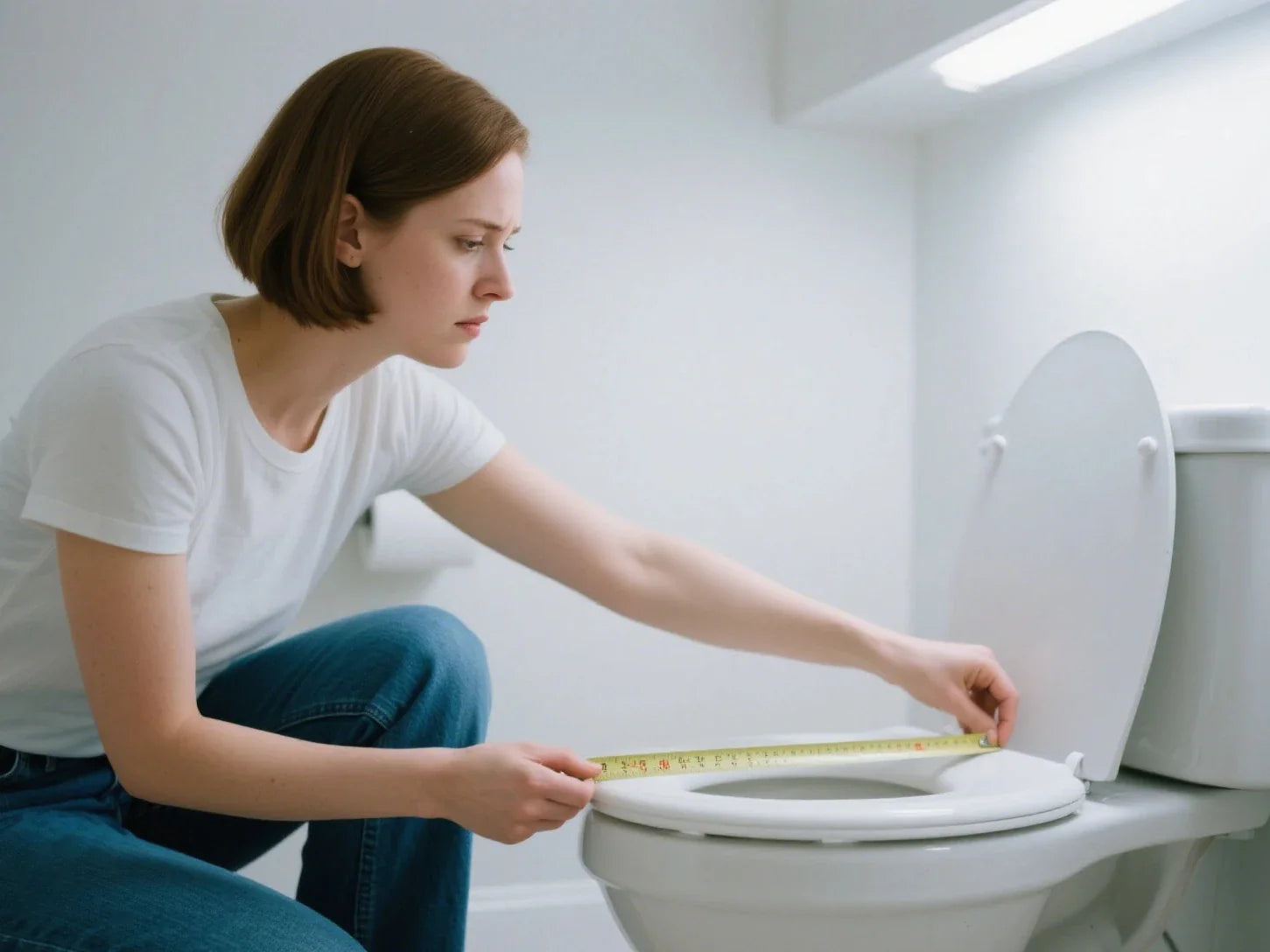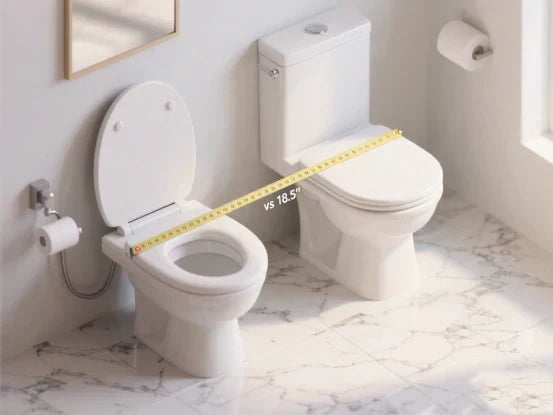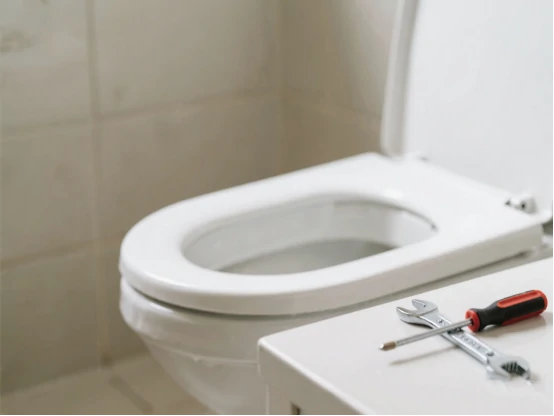Replacing a toilet seat refreshes your bathroom and boosts hygiene. A new toilet seat can make a common toilet more comfortable, safer, and easier to clean. In this guide, you’ll learn the whole process of toilet seat replacement: how to measure for a proper fit, which tools to use, and exactly how to remove and install your new seat. You’ll also find tips, troubleshooting steps, and a helpful checklist.
Why Is Toilet Seat Replacement Necessary?
A lot can happen to your toilet seat over time. Have you noticed stains or cracks? Does the seat wiggle, or is it hard to clean? Here are the most common reasons to consider toilet seat replacement:
- Hygiene: An old seat quickly collects germs, stubborn stains, and smells that regular cleaning can't remove. Studies from the CDC show that bathroom surfaces—including toilet seats—can harbor bacteria and viruses if not properly maintained, making seat replacement an important step in household hygiene.
- Comfort and Safety: Cracks, chips, or loose hinges make sitting uncomfortable and create a risk of pinched skin or even small injuries.
- Modern Upgrades: New seats often come with features such as soft-close lids, quick-release hinges for easier cleaning, or even heated seating.
- Recommended Frequency: Replace your seat every 3 to 5 years, or sooner if it looks worn or is difficult to clean.
Did you know? Old seats can break under pressure, especially if bolts become loose or the plastic starts to give way.
How to Measure a Toilet Seat
Choosing the right toilet seat starts with taking accurate measurements of your existing toilet. Although most toilets fall into standard categories, slight differences between brands and models can lead to poor fit or instability if not measured correctly.
Bowl Length
Measure from the center of the two bolt holes at the back of the toilet bowl to the very front edge of the bowl. A round toilet typically measures about 16.5 inches, while an elongated toilet measures closer to 18.5 inches. This is the most important measurement for determining seat shape and compatibility.
Bowl Width
Measure the width of the toilet bowl at its widest point, usually about halfway back. Standard width falls between 14 to 15 inches. While this measurement rarely varies much, it can help confirm overall seat compatibility, especially with designer or imported toilets.
Bolt Hole Distance
Measure the distance between the centers of the two mounting holes at the back of the bowl. In most modern toilets, this spacing is a standard 5.5 inches. If your toilet has a different spacing, it may require a specialty seat or adapter.
Bowl Shape
Visually assess the shape of your bowl. A round bowl is almost circular, while an elongated bowl appears more oval or egg-shaped. Comparing your toilet to a product photo online can help if you’re unsure. Some older or imported toilets may not fit perfectly into either category, so careful measurement is essential.
| Measurement | Where to Measure | Typical Size (inches) |
|---|---|---|
| Bowl Length | Center front to bolt holes | 16.5 (Round), 18.5 (Elongated) |
| Bowl Width | Widest point across the bowl | 14–15 |
| Bolt Hole Distance | Center-to-center at back | 5.5 |
| Bowl Shape | Round or Oval | Check shape visually |
Take care not to guess—measuring your toilet seat is the best way to make sure your new seat will fit securely. Using a tape measure and noting each value before heading to the store or shopping online can save time, returns, and frustration.
Tools and Materials for Toilet Seat Replacement
If you're planning to change toilet seats, you'll be happy to know it only requires basic toilet installation tools — many of which you likely already have at home. This makes it an easy DIY upgrade, even for beginners.
Tools
- Screwdriver: Flathead or Phillips, depending on the type of bolts securing your existing toilet seat.
- Adjustable wrench: Useful for tightening or loosening the nuts underneath.
- Pliers: Help you grip and turn hard-to-reach nuts during the process of removing or installing the seat.
- Rust penetrant spray: Ideal if you're struggling with how to remove a toilet seat that has rusted or stuck bolts.
- Cleaning spray or vinegar: Used to clean the area once you remove the old toilet seat and before attaching the new one.
Toilet Seat Replacement Checklist
| Task | Checklist ✅ |
| Measure the length of the toilet bowl and width | |
| Check bolt hole distance | |
| Buy a seat that will fit your shape and size | |
| Gather all tools (screwdriver, wrench, etc.) | |
| Put on gloves (optional) | |
| Remove the old seat and hardware | |
| Clean the toilet rim | |
| Place the new seat and secure bolts | |
| Test seat for movement and fit | |
| Re-tighten or adjust as needed |
Step-by-Step Guide to Replace a Toilet Seat
Ready to start? Here are simple instructions on how to remove toilet seat and replace a new one. The process is straightforward—even for beginners. As noted by Benjamin Franklin Plumbing, you only need a screwdriver and a wrench to swap out most toilet seats in under 20 minutes.
Measure Bowl and Seat
- Use a tape measure to check bowl length (front edge to center of bolts).
- Measure width at the widest point.
- Measure the distance between bolt holes.
- Confirm if your toilet is round or elongated.

Remove Old Seat
- Find the bolt housing caps at the back.
- Use a flathead screwdriver to pry up the caps.
- Find the bolts and two plastic nuts under the bowl.
- Hold the nut with pliers; use a screwdriver from the top to unscrew the bolt.
- If bolts are rusty, spray with rust penetrant or household vinegar and wait a few minutes.
- Finish removing bolts and lift away the old toilet seat.
Clean the Toilet Rim
- Wipe around the toilet rim and bolt holes using cleaner or vinegar.
- Dry with a clean cloth.
- Make sure the area is smooth and free of dirt before installing the new seat.
Install the New Toilet Seat
- Position the new seat over the holes.
- Insert the new bolts through seat and bowl holes.
- Secure the seat by tightening new nuts underneath (use fingers, then a wrench).
- Snap on the bolt caps, if there are any.
- Don’t over-tighten! Too much force can damage the toilet.
Test Fit and Function
- Gently wiggle the seat to check it’s snug.
- Open and close the lid—see if the soft-close works, if included.
- Sit to make sure it’s steady.
Troubleshooting about Toilet Seat Replacement
Stuck? Here are solutions to common problems and questions about toilet seat replacement.
Stuck Bolts
- How to unscrew a toilet seat when bolts won’t budge? Try WD-40 or other penetrating oil. Wait 10 minutes, then use a toilet seat wrench or pliers. If bolts still refuse, a small hacksaw may be needed.
Dealing with Unusual Toilet Shapes
Can all replacement toilet seats fit any toilet? Most seats fit standard round or elongated bowls. But some imported or very old toilets need a special order seat—measure carefully! Some older or imported toilets may not match standard round or elongated shapes.
- How to Identify: Measure carefully and take a picture of your current setup.
- Contact the Manufacturer: Look under the tank lid or behind the bowl for brand/model numbers.
- Aftermarket Brands: Specialty retailers or universal-fit seat makers may carry odd-sized options.
- Adapters or Custom Seats: Some companies offer toilet seat spacers or custom-fit services for unusual shapes.

Maintenance Tips for Long-Lasting Toilet Seats
Proper care keeps your toilet seat clean, functional, and safe for longer. Follow these practical maintenance steps to prevent wear and improve hygiene.
Weekly cleaning
Wipe down the toilet seat and bowl rim using mild soap or a vinegar-water solution. Be sure to clean both the top and underside of the seat. Avoid harsh chemicals like bleach and abrasive scrubbers, which can damage certain seat finishes.
Disinfect hinges and bolts
Use a cloth and a disinfectant spray to wipe around the hinges and under bolt caps. This prevents the buildup of grime and helps keep rust from forming on metal components.
Monthly deep cleaning
If your seat has a quick-release feature, remove it and clean thoroughly around the bolt holes and hinge area. This keeps hidden bacteria and mineral buildup from accumulating.
Every 2 to 3 months
Check that all bolts and nuts are tight. Gently wiggle the seat to detect looseness. If necessary, use a screwdriver or wrench to secure the hardware. Loose fittings can cause cracks or make the seat unstable during use.
Inspect for damage
Look for signs of wear, including surface cracks, stains that won’t clean off, or a seat that shifts during use. These are indicators that a replacement may be needed soon.
When to replace
Don’t wait for the seat to break completely. Replace it at the first sign of structural damage or when cleaning no longer restores its appearance. In humid climates or high-use households, plastic seats may degrade more quickly. Wooden or composite models may last longer but still require regular checks.
Consistent maintenance not only improves hygiene but also extends the life of your toilet seat. Taking a few minutes each week and performing a full check every few months can help avoid sudden repairs or inconvenient seat failures.
Types and Sizes: Choosing the Right Toilet Seat
The hardest part of changing a toilet seat is often picking the right one. Toilet seats come in two main shapes:
- Round: About 16.5 inches from front to back.
- Elongated: About 18.5 inches long, slightly oval.
Materials and Features
- Plastic: Lightweight, easy to clean, and budget-friendly.
- Wood: Warm feel, heavy, stylish for some bathrooms.
- Composite: Mix of resins and wood fibers—strong and durable.
Popular Features
- Soft-close: Prevents loud slams, safer for young children.
- Quick-release: Hinges allow the toilet seat removable in just seconds, making deep cleaning around the seat area much more efficient.
- Heated or bidet-compatible: Comfort and extra hygiene.
Key tip: Always measure your toilet bowl before buying. Even if you think you have a standard toilet, there can be small differences.

Accessibility and Eco-Friendly Options
According to the World Health Organization, access to clean and sanitary bathroom facilities is essential for health and dignity. Upgrading toilet seats regularly supports both personal hygiene and accessibility for all users. Bathroom upgrades work best when everyone can use them. Here’s how you can pick a seat for special needs and for the environment.
Accessibility
- Elevated or ADA-compliant seats: These make sitting and standing easier for children, seniors, or anyone with limited movement.
- Child-friendly seats: Smaller, easy-grip, or removable potty seats offer extra safety.
Eco-Friendly Choices
- Bamboo or sustainably sourced wood: Reduces plastic use.
- Recyclable seats: Some plastic seats and composite seats are made from recycled material.
- Quick-remove designs: Easier to keep clean, so you won’t need to use as many harsh chemicals.
Comparison Table: Popular Toilet Seat Options
| Feature | Plastic | Wood | Composite | Soft-close | Quick-release |
| Price Range | $ | $$ | $$ | $-$$$ | $-$$ |
| Durability | Medium | High | High | High | Medium-High |
| Maintenance | Easy | Medium | Easy | Easy | Easy |
| Eco-friendly | Varies | Yes | Varies | Varies | Varies |
- Plastic seats are best for budget and easy cleaning.
- Wood or composite offer more warmth and durability.
- Soft-close and quick-release features suit busy or family bathrooms.
Real-World Insights
User Survey Snapshot
Users say:
- Plastic seats are easiest to install and clean but can stain faster.
- Wood and composite seats feel warmer and last longer but cost more up front.
- Soft-close and quick-release mechanisms greatly improve cleaning and safety—especially in homes with little kids.
Installation Pitfalls
Common complaints:
- Rusted or hidden bolts are the biggest struggle during toilet seat removal.
- Some new seats won’t fit odd-shaped or European-style toilets.
- It’s easy to misalign the seat if you do not check that the bolts go straight through both holes.
What helps?
A toilet seat removal tool, patience, and following a simple checklist removes most headaches, even for first-time DIYers.
Conclusion and Recommendations
Toilet seat replacement is an easy way to keep your bathroom looking sharp and feeling comfortable. Just measure carefully, pick the right toilet seat, and have your screwdriver, wrench, and cleaning spray ready. For budget, pick plastic seats. For style and warmth, try wood or composite. Soft-close lids are great for families and cut noise.
FAQ
1. How do I find the correct replacement toilet seat?
To pick the right seat for your toilet, the measurements have to be right. Start by taking a ruler and measuring three key dimensions: the length from the bolt holes in the back of the toilet to the front, the width at the widest point, and the distance between the two mounting holes (typically 5.5 inches). Then take a close look at the overall shape of the toilet to distinguish whether it's a rounded, round model or a slim, long model. With this data in mind, you'll be able to find the perfect toilet seat, whether you shop in a brick-and-mortar store or order from an online store.
2. Can I just replace the seat on an old toilet?
Of course you can change it! There's no need to buy a new toilet just to change the toilet seat. The toilet seat itself is designed to be removed and replaced at any time, whether it's worn out, accidentally damaged, or you simply want a new style, it's easy to do. Replacing the toilet seat on a regular basis can be so practical, not only will it improve your health and make you sit more comfortably, but it will also give you more value for your bathroom, and crucially, it's a great deal as you don't have to spend a fortune replacing the whole toilet or go through the hassle of redecorating!
3. Are toilet seat replacements universal?
Don't assume that all toilet seats are universal! Most toilet seats on the market are categorized into two mainstream sizes: round and long. However, vintage toilets in older homes, imported models, or specially shaped toilets often have different sizes and shapes than regular toilets. Because of these differences, be sure to carefully measure the length, width, and bolt spacing with a ruler before purchasing a new toilet seat. Only if the dimensions are measured accurately will the new seat fit snugly. Otherwise, if you buy one at random, you will likely face the embarrassment of not being able to fit it, or wobbling when you do. Taking a few minutes to measure in advance can really save you a lot of trouble!
4. How often should I replace my toilet seat?
From the perspective of hygiene and comfort, it is generally recommended to replace the toilet seat once every 3 to 5 years. However, if you find cracks on the seat, there are stubborn stains that can not be washed out, or sit shaky, how to twist the seat is loose, then do not wait, hurry to change the new one is reliable. Usually pay more attention to maintenance can make the toilet ring longer, but the time to change do not hesitate to always ensure the use of safety and cleanliness, after all, this is the daily use of things, careful no big mistake!
References
- Centers for Disease Control and Prevention (CDC). Handwashing: Show Me the Science
- World Health Organization (WHO). Sanitation Fact Sheet
- Benjamin Franklin Plumbing. How to Install a New Toilet Seat
- Southern Living. How Often Should You Replace a Toilet Seat?








Leave a comment
This site is protected by hCaptcha and the hCaptcha Privacy Policy and Terms of Service apply.